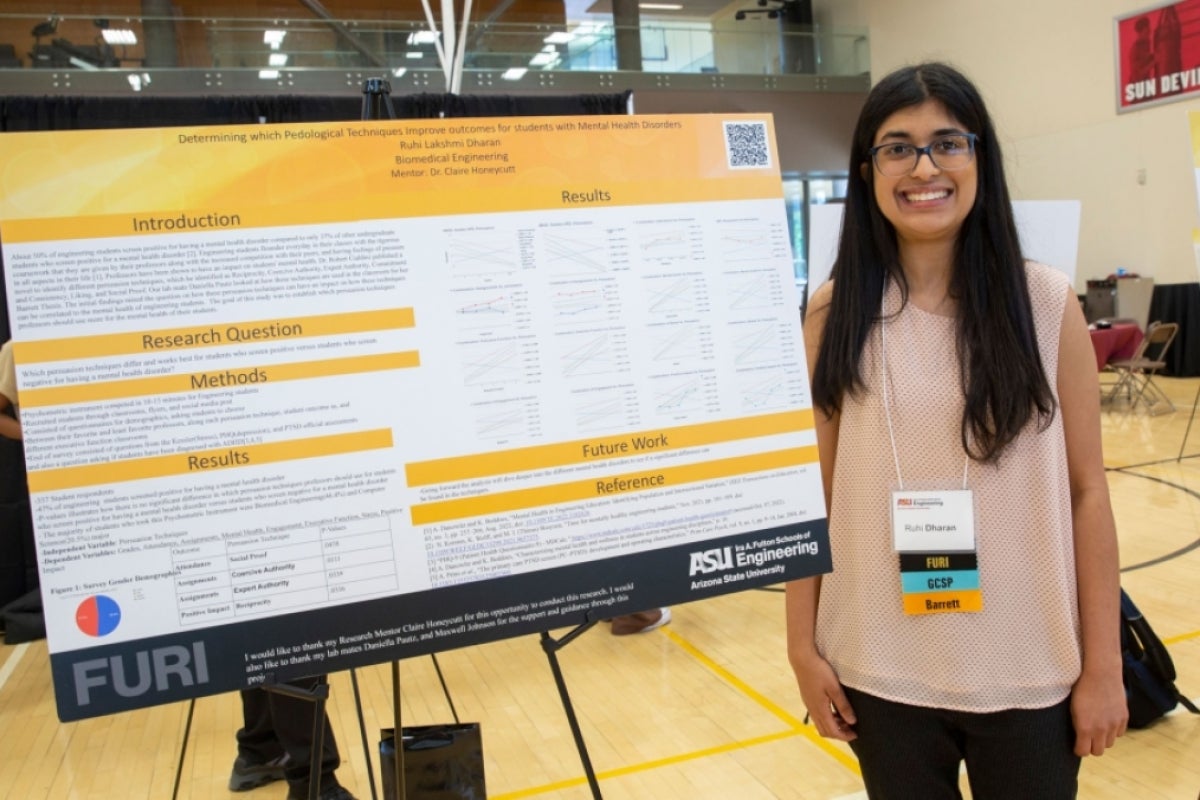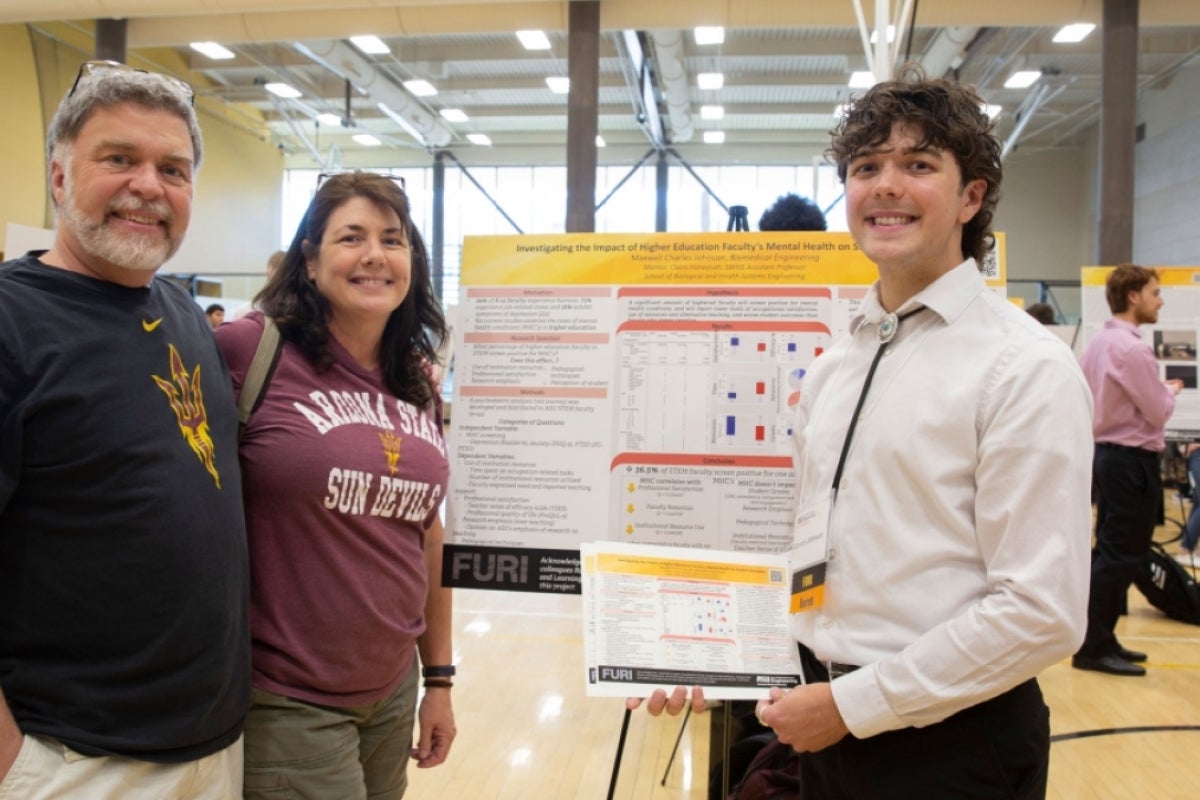ASU students explore mental health in engineering education

Arizona State University biomedical engineering students (left to right) Ruhi Dharan, Daniella Pautz and Maxwell Johnson are studying the effects of teaching methods on engineering students’ well-being as well as faculty mental health. Photo by Erika Gronek/ASU
According to a study, half of all undergraduate engineering students in the United States screen positive for a major mental health condition or significant distress. The rates can be even higher among high-achieving students and populations underrepresented in engineering fields.
“Most people I know in engineering either suffered from anxiety or depression, or saw their peers suffer from it,” said Daniella Pautz, who graduated in May with a master’s degree in biomedical engineering from the Ira A. Fulton Schools of Engineering at Arizona State University.
“Especially because we completed half of our degree online through COVID, loneliness and stress levels were higher than ever,” she said. “College is difficult enough, but seeing my friends suffer the way they did made me realize a change was needed.”
This desire to help led Pautz to set a new course of student-led research at ASU alongside Claire Honeycutt, an assistant professor of biomedical engineering, and undergraduate biomedical engineering students Ruhi Dharan and Maxwell Johnson to explore mental health in engineering higher education.
An opportunity to make a difference
Pautz has always loved math and science and wanted to become an engineer. She also gained a passion for teaching in high school by tutoring her peers.
As an undergraduate student at ASU, Pautz found Honeycutt to be a particularly effective and inspiring teacher after taking one of her classes and working in her lab. As an honors student in Barrett, The Honors College, Pautz needed to complete a thesis research project, and she chose Honeycutt as her advisor.
Honeycutt’s research typically focuses on clinical biomechanics, motor control, stroke, falls and orthotics. However, the timing of Pautz’s honors thesis work lined up with the height of the COVID-19 pandemic, providing a unique opportunity to explore Pautz’s interest in education.
“I had been increasingly interested in psychology-based techniques to increase student outcomes such as grades, well-being and community,” Honeycutt said. “I had been using these techniques in my classroom for several years and wanted to quantify their success. As my lab was shut down, COVID allowed us the opportunity to do just that.”
Honeycutt and Pautz specifically looked into Robert B. Cialdini’s six methods of persuasion: liking, reciprocation, consistency, scarcity, social proof and authority. He defined these methods without education in mind. However, they can be used to help build relationships, manage decisions and increase motivation, which are also important in the classroom.
In her honors thesis, Pautz investigated how ASU engineering professors’ use of these persuasion methods in their teaching affected students’ stress and performance.
“The data from her honors thesis was preliminary, but something quite striking came out of it,” Honeycutt said. “I thought that these psychological principles would influence grades, but her work suggested that it might do something much more significant than that. They might decrease anxiety and improve mental health in the classroom.”
Honeycutt said Pautz was a pioneer in the lab for this type of research. To help realize its potential, Honeycutt helped Pautz further refine the project for her master’s degree thesis and recruited Dharan and Johnson to contribute to further research. In addition to Honeycutt’s mentorship, their work was supported by the Fulton Undergraduate Research Initiative, or FURI, and Master’s Opportunity for Research in Engineering, or MORE, programs.
A closer look at student mental health
Pautz’s next phase of research for her master's degree thesis focused more closely on how inclusive versus authoritarian persuasion methods affect mental health in addition to stress and academic outcomes.
She developed a survey, taken by more than 300 engineering and technology students at ASU, to evaluate students’ perceptions of their professors’ use of persuasion techniques. The surveyed students also rated their own academic and mental health outcomes.
Pautz’s research concluded that professors who use persuasion methods that focus on enhancing community, relationship building and improving students’ sense of belonging were perceived as the most effective teachers.
“Their students have better mental health, decreased stress and better grades,” Pautz said.
Conversely, professors who used rules and punishments — such as requiring class attendance and restricting computer or smartphone use — had a negative impact on students, including increased stress, worse grades and worse mental health.
Pautz’s work was supplemented by Dharan’s research to screen students for mental health conditions and analyze whether certain persuasion techniques are more or less effective for students who screened positive.
“I hope to help professors understand what their students are going through and how their tactics affect their students' health,” Dharan said.
Dharan found her sophomore year to be particularly difficult. The course load of her engineering degree and the difficulty of finding internships have at times caused her to want to change majors. She said she has noticed many of her peers share her experiences.
Similar to other published research about engineering students’ mental health, Dharan’s survey results indicated that 47% of the ASU engineering and technology students who responded screened positive for mental health conditions. The survey included assessments used in clinical diagnoses of depression, anxiety and post-traumatic stress disorder and asked if students had been diagnosed with attention-deficit/hyperactivity disorder, or ADHD.
However, Dharan’s findings related to persuasion methods were less clear. In her research so far, none of the persuasion techniques showed a significant difference in effectiveness for students who screened positive or negative for mental health conditions.
“This is not necessarily a bad thing,” Dharan said. “It could just mean both groups have the same feelings for their professors regardless of their mental state. I am planning to dive deeper into analysis to see if I can find anything that will be significantly impactful for students in the long run.”
How are the professors feeling?
When biomedical engineering junior Maxwell Johnson learned about Pautz’s research from Honeycutt, he started thinking about the faculty side of the equation.
“The main motivation for my research was the apparent necessity of investigating faculty mental health,” Johnson said. “No statistics are known about the mental health rates of professors in higher education. Since the metric for student rates of depression and anxiety is shockingly one in every two students over a four-year degree duration, I wanted to peel back the cover on what these numbers looked like for teachers and see how they compared.”
Johnson’s research assessed the prevalence of mental health disorders in ASU engineering and technology faculty members and how that affected the professors’ teaching styles, student outcomes, job satisfaction and other factors.
He found that more than a third of faculty members surveyed experienced symptoms of one or more mental health conditions, which included depression, anxiety and PTSD. Johnson also found a correlation between screening positive for mental health disorders and a lower sense of professional satisfaction, working longer hours, feeling less supported and not using resources available to help them.
However, he found that faculty members’ mental health did not seem to impact the teaching and persuasive techniques they use, how effective they thought they were at teaching or their students' grades or attendance.
“One thing I think students forget is that teachers are people, too, and face the same issues and struggles as everyone else,” Johnson said. “This data advocates for better support for mental health, especially in schools with STEM connections.”
Actionable results and future work
Pautz’s research efforts have uncovered new ways that professors can help improve the performance and mental health of students pursuing careers in engineering and technology.
“Many of the principles that Daniella is evaluating have the potential to be added to the classroom with low faculty effort, such as five- to 10-minute exercises, or policy-level changes like flexible deadlines,” Honeycutt said. “Our goal is to provide a list of evidence-based techniques to assist our students with mental health disorders.”
Pautz’s work has also inspired her collaborators to continue to look for ways to address this important issue in higher education. Dharan plans to continue investigating this topic and publish the findings in a research journal to inspire educators to implement positive techniques in their classrooms.
“The data collected through this project will inform not only ASU but could be expanded to inform any higher education institution,” Honeycutt said.
Johnson has been working closely with the Fulton Schools Learning and Teaching Hub during the design and execution of his experiment. The hub was created in 2021 to provide faculty with professional development opportunities, teaching strategy resources and tools for effective education. He is also sharing his findings with them to provide a clearer picture of faculty resource needs.
Kristen Peña, program manager for the hub, said she and her colleagues learned valuable information from Johnson’s work about how the faculty used or didn’t use the resources they provide.
“We want to raise awareness of the many resources and services available to faculty and to also think holistically about how to embed those resources in our professional development offerings,” Peña said.
The hub is developing quick reference guides and asynchronous learning materials for faculty to learn the techniques that Honeycutt and Pautz found increased student motivation and performance.
“Our goal in embedding these topics is so that it doesn’t feel like there is a barrier to access or confusion navigating what’s out there,” Peña said.
Peña said hub staff is also thinking about how they can help create safe spaces for faculty members to share their struggles.
Johnson plans to expand his research with Honeycutt to explore faculty mental health in a larger population, including faculty members at other universities, and start a new project to generate specific recommendations for university administrators based on his results.
With a fresh degree in hand, Pautz is beginning a systems engineering position at Sandia National Laboratories. One day, she wants to be a teacher or professor, and she can draw upon her research findings and her own experiences with different teaching methods throughout her education.
“Engineering is a difficult major, and the effectiveness of a professor has a huge impact on your success,” Pautz said. “It doesn’t matter how much knowledge a professor has if they can’t keep their students motivated, build a relationship with them and help them learn.”
More Science and technology

ASU professor honored with prestigious award for being a cybersecurity trailblazer
At first, he thought it was a drill.On Sept. 11, 2001, Gail-Joon Ahn sat in a conference room in Fort Meade, Maryland.…

Training stellar students to secure semiconductors
In the wetlands of King’s Bay, Georgia, the sail of a nuclear-powered Trident II Submarine laden with sophisticated computer…

ASU startup Crystal Sonic wins Natcast pitch competition
Crystal Sonic, an Arizona State University startup, won first place and $25,000 at the 2024 Natcast Startup Pitch Competition at…


